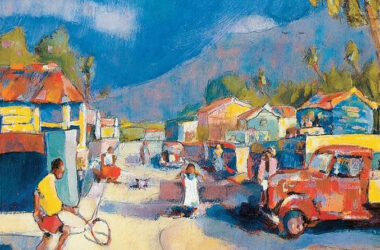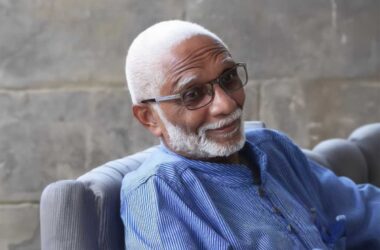When Marcus Garvey visited Saint Lucia 100 years ago in 1921, Saint Lucians turned-out in large numbers to see and hear the leader of the Universal Negro Improvement Association (UNIA) and African Communities League (ACL).
They’d heard of the UNIA and its influence among Black people worldwide and across the then British West Indies; now they’d be able to see and hear him, live and direct.
Saint Lucia was among ten British colonies Garvey would visit two years after the UNIA was launched, overnight becoming the biggest organization of Black people globally, with three million registered members and growing to influence over 11 million worldwide.
Garvey’s visit was momentous in many respects, from his several nightly lectures at Clarke’s Cinema to the oral historical reports of how the local branch of the UNIA handled his security.
The Archives Authority will have reports of The VOICE covering what Garvey said at the cinema, but his message went down well not only with Saint Lucian intellectuals, but also the average clerk and stevedore, factory or estate worker – including those who never heard of him but were encouraged by others to listen to him.
The Saint Lucia branch of the UNIA was led by Wilberforce Norville, who lived at Hospital Road in Castries.
Anecdotal accounts have it that since Garvey was always to be monitored while here by the colonial police, he was officially domiciled at Bishop’s Gap in Marchand, near the official residence of the Chief of Police.
But the UNIA leaders here did not trust leaving Garvey’s security in the hands and eyes of the colonial police and devised an interesting scheme to take him away, unseen, by night, to safer premises.
This was done by having Garvey lie in a traditional emergency hammock (a bedsheet folded to hang off a bamboo pole carried by two men) and ferried out of the house ‘by the back’ to the Marchand main road, where no-one would have thought Marcus Garvey was being ferried in the day’s domestic ambulance.
Garvey would then be taken to Norville’s private residence in Fau-a-Chaux, in the house next to the community’s age-old public standpipe.
There are three aspects of Garvey’s Saint Lucia connection I wish to address on this the 101st anniversary of his visit.
First, the connection with Arthur Lewis, who was only six years old when Garvey came…
Garvey died in 1940, but one year before, Lewis wrote his inaugural seminal book Labour in the West Indies (1939) that embraced much of Garvey and the UNIA’s philosophies, making the case for Reparations for people of African descent in the British West Indies after centuries of slavery, colonial exploitation and neglect.
Lewis’ book, penned immediately after he took time-off as a 23-year-old first Black university lecturer on the London circuit to travel the British West Indian islands that had revolted in 1938, to observe the conditions that led to what he clearly described as ‘revolutions’.
Lewis would be very-much influenced by Garvey’s words and works later in life while serving as an economic advisor to President Kwame Nkrumah, when Ghana became the first British colony in Africa to gain independence.
The name of Garvey’s famous ‘Black Star Line’ (four ships be bought with supporters’ contributions to take Africans the world over back home) was also given to the new nation’s first shipping company.
My second reference point is John Quinlan, a Saint Lucian, who, like Garvey and Lewis, but long before both, championed the causes of People of African descent after supposed Abolition of Slavery and Emancipation.
Garvey was born in 1887 and was only ten years old when Quinlan, a humble land surveyor from La Clery in Castries, addressed Britain’s Royal Commission investigating the conditions of ex-slaves following Emancipation and Apprenticeship.
Like Garvey, Quinlan had a world view of conditions facing Blacks in British and European colonies and he traveled to Curacao, Panama and Cayenne to personally bear witness to the conditions under which ordinary migrant Saint Lucian families suffered to live.
Fifty years after Abolition, the ‘emancipated’ ex-slaves had suffered five decades of abandonment across the colonies, replaced by indentured labourers imported from India to keep the plantations producing profits for their European colonial masters.
Quinlan was associated with the Pan African movement and made representation to the Royal Commission in 1897 on behalf of the millions of ex-slaves and their descendants in the Americas and the West Indies; and later he would attend the launching of the Pan African Congress in London in 1900.
A third Saint Lucian, one of mysterious origin, but fits into this category of the unknown or unacknowledged ‘Emancipation Heroes’ is Joseph Seligny Baron, described by researcher Lawrence Poyotte as “a coloured native of Saint Lucia, who for some time was a merchant in Shanghai in the Empire of China.”
This is the Baron who paid for construction of a gothic structure in Castries to house injured, abandoned and destitute ex-slaves abandoned by estate owners because they were unable to ‘work’.
Not much was known about how Baron made his money in Shanghai, but he left a pretty hefty sum to construct the original home for the destitute and abandoned in Castries, which was found too good for the persons intended and transformed to the old Police Headquarters that’s the last building still standing on Bridge Street.
Those in charge then constructed a second structure at Malgretoute in Soufriere, commonly called ‘Lopital Bawon’ and historically treated as a home for lepers at the end of Baron’s Drive (Coin l’Anse) along the Soufriere waterfront.
Baron, who resided in the UK, had left ‘two sixths’ of his financial estate in Saint Lucia to care for the ex-slaves and abandoned persons, which money was instead deflected to uses that did not fully guarantee his will to help the neediest of his fellow Saint Lucian citizens.
Indeed, Garvey’s visit to Saint Lucia was not just an event…





